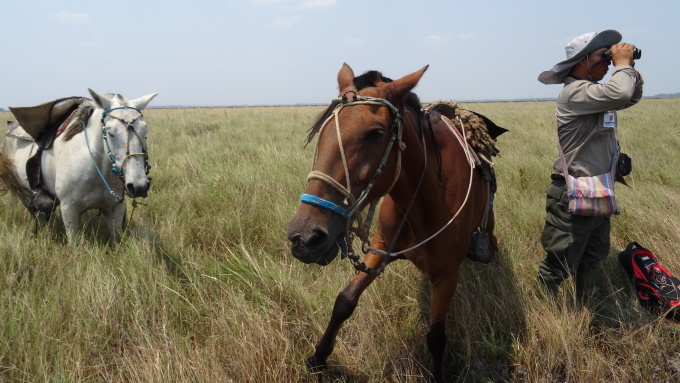
- Conservation trust funds are said by some to take money away from urgent needs now, especially for land acquisitions, where it is often a case of ‘now or never.’ While donors do prefer to support the creation of new protected areas, the under-funding of protection and management results in “paper parks” and under-protected reserves.
- More funds could be allocated for protection on an annual basis, and trust funds are also a valid option.
- Endowments reduce the heavy burden on local conservation organizations who must spend a lot of time fundraising and administering multiple grants each year, a founding director of the International Conservation Fund of Canada writes.
- This article is a commentary. The views expressed are those of the author, not necessarily of Mongabay.
Why endow funds for conservation? Some argue that it takes money away from urgent needs now. Conservation trust funds secure finance for long-term costs, typically protection and management of nature reserves. But long-term funding can be provided year-to-year, so why “tie it up” in a trust fund?
Part of the answer is that trust funds do not necessarily redirect money from immediate action. Some conservation philanthropy comes from major donors and funders. Those who wish to support long-term costs for reserves or conservation programs can do so either year-by-year or by contributing to an endowment. Major-gifts donors usually retain capital to generate earnings long term, and it makes no fundamental difference whether earnings are generated within a conservation trust fund or in private holdings. The two options are not identical, however. Investment earnings of charities are not taxed (an advantage). On the other hand, the performance of privately invested assets is likely to be higher. Many conservation trust funds follow a conservative investment strategy that provides steady low returns, but there is nothing to stop trust funds from following a more flexible risk-tolerant strategy that provides a higher longer-term yield.
Isn’t it nevertheless the case that a million dollars can buy land now – land that may not be available ten years from now? Yes, that’s true and we’re not arguing against spending money now to acquire land or otherwise secure terrestrial or marine reserves. Securing primary forest and other intact tropical ecosystems is a particular priority. And there are other conservation actions that reduce threats to species and ecosystems that require only short-term funding.

But most donors and funders prefer to fund those things and so funding for land securement is not threatened by endowments. This is the reason that many land trusts in developed countries now stipulate that a percentage of funds given for acquiring land be set aside in an endowment to keep the land protected. They have found that their donors fail to understand the costs of protecting land long term and much prefer to contribute to land acquisition.
Another rap against endowments is that money goes much further now than it will in future. This is true. As the standard of living improves in developing countries (a good thing) the price of land will increase even where populations are not increasing, and costs for wages will be higher (again, a good thing). But financial assets that are well invested also increase in value. One US dollar in 1980 is worth $3.41 in February 2022, yet across that timespan the Dow Jones increased by a factor of 35, rising from less than 1,000 in 1980 to about 35,000 today. So, financial assets also rise in value, even if less, in some cases, than real estate and other conservation costs.
In many areas of the world protected areas exist in name only – so-called paper parks – because of an acute shortage of funds to protect and manage them. This is a particular problem in countries with inadequate law enforcement. Private reserves are generally well protected and managed by local conservation organizations, but in developing countries, finding funding for this is a problem. When funders “exit” after creating a protected area or governments under-fund ones they have designated, the area can end up degraded or destroyed, which means the earlier investments have been devalued.
It is argued that instead of relying on endowments, conservation organizations should develop revenue generating activities such as ecotourism. This is much easier said than done and the potential varies widely. For most local conservation organizations, even those with highly developed ecotourism, commercial revenue streams cover a modest portion of the organization’s operational expenses. There is growth potential for forest carbon credits and payments for water ecosystem services, and that may help with some reserves, but will not be the answer for others.
There is one more important consideration. Conservation organizations must spend a lot of time raising funds for ongoing costs. With steady income from a trust fund, they can devote more of their time to the work that directly yields conservation benefits. Since funders and donors end up paying the heavy fundraising and grant administration costs of the organizations they support, avoiding those expenses represents a significant cost saving. The uncertainty of future funding also imposes a considerable psychological cost on the people leading local conservation organizations. And organizations that have some long-term financial security should have an advantage in attracting funding for land acquisition.

Can conservation endowments go astray?
There is a valid concern that endowments could cause complacency or that funds could be inappropriately diverted for some “emergency”. That could occur if the administration of the fund is lax. This risk is considerably lower if the fund is controlled by a party other than the implementing organization. Local organizations or agencies managing reserves can go astray regardless of whether there’s an endowment. And a trust fund can help in that event, including by securing the services of other local conservation organizations.
In a few cases, a long-term finance mechanism is a required pre-condition for land conservation. This was the case when the Los Amigos Conservation Concession was created by the government of Peru in 2000 by agreement with the Amazon Conservation Association. In that case a trust fund was put in place through private philanthropy.

When is a conservation trust fund appropriate? An organization might consider it when:
- there is a need to demonstrate (to governments or others) that reserves can be protected indefinitely
- a long-standing successful conservation operation is secure but the work to obtain funding year-to-year imposes a large burden on the implementing organization
- there is an excellent experienced local partner with good long-term prospects (but note that the trust fund is restricted for a particular purpose and not for an organization)
- the needed scale is large enough (for us, at least a 7-figure endowment)
- a donor either requires an endowment to be in place when participating in a land acquisition or wishes to make a very large gift and apply the funds over a long period (perhaps as a sinking fund)
What makes an effective trust fund? My own organization has no special expertise, and we would not want to contribute to one unless: (i) the fund is efficiently administered, with reasonable reporting and oversight; (ii) financial assets are well managed; (iii) disbursement of funds is conditional on satisfactory results; and (iv) there is flexibility built in so the fund can respond to changing circumstances.
In summary: Funding is inadequate for protecting existing reserves because funders and donors prefer to “save” land by creating new protected areas. Allocating more annual funding for ongoing protection is a good answer to this problem. Conservation trust funds are another valid option, and these are unlikely to divert funding from immediate conservation needs. Creating reserves is vital, but so is ensuring that they are not protected in name only.
Anne Lambert is a founding director of the International Conservation Fund of Canada.
Related audio from Mongabay’s podcast: Funding for tree kangaroo conservation may be key to forest protection in New Guinea, listen here:
Are conservation trust funds part of the answer for ongoing land protection? (commentary)
Source: Trends News

0 Comments